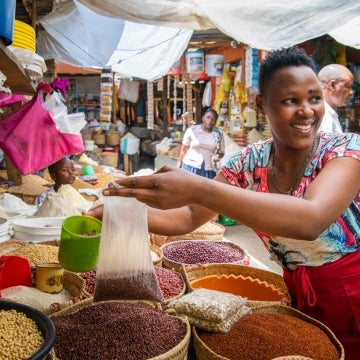In the evolving landscape of Africa’s digital economy, cross-border e-commerce (CBEC) has emerged as a transformative force, particularly for rural women entrepreneurs. For women cross-border traders, many of whom engage in agriculture, CBEC and simplified trade procedures offer an opportunity to expand beyond local markets, boost their incomes, and create a financial footprint that can lead to a suite of financial products.
For Mwanama*, a small-scale maize trader at the Isebania–Sirari border between Kenya and Tanzania, e-commerce has transformed how she does business. She began trading informally across the border by taking orders via phone from customers and delivering them locally using tuk-tuks (auto-rickshaws). As her customer base grew, she officially registered her business, enabling her to trade under the East Africa Community Customs Union Simplified Trade Regime (STR). The regime is a special provision designed to ease cross-border trade by reducing paperwork and delays in clearing goods as well as offering no import duties in the destination country on consignments of goods below USD 2,000. The STR encourages the formalization of informal cross-border trade, specifically for small-scale traders. Since her registration, Mwanama has also used reliable courier services to reach new markets across the border, as opposed to the informal couriers she previously relied on.
When it comes to cross-border communication and transactions, initiatives such as the One Network Area (ONA) – which harmonizes mobile communications and reduces roaming charges – are crucial. Through the ONA, Mwanama uses social media platforms such as WhatsApp and Instagram to promote her business, and calls clients in East Africa while on the go. In some cases, women like Mwanama are able to access working capital loans from SACCOs, digital credit from mobile providers, or informal supplier financing based on their trade volumes. While the financial products are often small and short-term, they represent an important step toward formal financial inclusion for many women entrepreneurs.’
Despite the gains made, Mwanama still faces challenges in meeting the technical and phytosanitary requirements for selling maize, notably due to costly and duplicative certification processes. E-commerce efforts aim to find the optimal balance between building visibility and trust and avoiding scrutiny and tax exposure, among other trade barriers that remain a key tension for women like Mwanama.
Cross-border e-commerce in Africa
Africa’s e-commerce sector is growing. The International Trade Administration estimates that the continent will surpass half a billion e-commerce users by 2025, reflecting a steady 17% compound annual growth rate. This growth is largely driven by advancements in digital infrastructure, mobile connectivity, and digital literacy, providing new pathways for economic development. This will be particularly significant for women engaged in small-scale cross-border trade, many of whom currently operate informally, using mobile money and informal courier services to move goods across semi-porous borders via boda-bodas (motorbikes) or matatus (minivans). In border towns such as Busia and Malaba (Kenya), women constitute approximately 80% of the trading population, with total trade valued at around US $300 million.
Empowering women through digital trade in East Africa
International cooperation plays a pivotal role in advancing CBEC in East Africa. With support from Germany’s development ministry and implemented by the German development agency GIZ, regional projects in the East African Community (EAC) aim to strengthen cross-border trade by harmonizing standards, improving access to finance, and enhancing digital capacities and awareness, among other essential skills for women traders. Informal cross-border trade can be both costly and risky for women. Many face frequent clashes. Frequent clashes with local authorities and the threat of having goods confiscated loom over informal trading. Conversely, formalizing trade can lead to shorter processing times, improved access to duty exemptions through simplified trade schemes, and greater protection from harassment or extortion — particularly for women traders. These benefits help streamline business operations and reduce risk.
CBEC, with support from the EAC, also opens markets for small-scale traders. Platforms like KilimoMart, an application that connects small-scale farmers in Uganda to regional markets, have enabled women cross-border traders to easily interact with customers, access real-time market information, and sell organic processed products (such as moringa, coffee, and cassava flour) online.
The World Bank is also supporting efforts to expand cross-border e-commerce in East Africa. In Somalia, a pilot is underway to assess how simplified trade procedures can make it easier and cheaper for small traders to move low-value goods between Kenya and Somalia. Much of this trade — in livestock, rice, pasta, and other staples — already happens informally. Simplifying the rules can help bring more of it into the formal system, making trade safer and more profitable for small-scale traders.
Barriers to digital inclusion
Despite the opportunities that CBEC presents for rural women traders, several challenges continue to impede its full participation. While mobile money platforms like Kenya’s M-Pesa enable cross-border transactions, the high costs of transfers, expensive mobile data, and low digital literacy remain significant barriers. Additionally, regulatory barriers such as inadequate systems for national identification, limited interoperable digital financial services, and lack of easy access to information make it difficult for women cross-border traders to meet the basic formal trade requirements. Moreover, many traders are unaware of where to seek assistance in resolving the challenges they encounter during trade or where to file complaints when issues arise. As a result, a significant proportion of cross-border trade continues to operate informally.
Pathways to inclusive digital trade
Current data on e-commerce cross-border trade in East Africa is limited, suggesting either that digital trade remains a small portion of total cross-border activity or that existing measurement systems are not adequately capturing emerging e-commerce transactions. To address this knowledge gap, funders and policymakers should prioritize comprehensive surveys of cross-border traders, for example, and systematic analysis of mobile money flows and digital platform transactions to better understand their digital adoption patterns. This will enable more informed policy decisions about digital trade and help identify the specific barriers that prevent traders, especially women, from fully leveraging e-commerce opportunities.
The road ahead may be challenging, but with stronger regional collaboration, smarter digital infrastructure, and tailored support for small-scale women traders, CBEC can be a powerful engine for women’s economic empowerment and a driver of inclusive growth across the region.
* Name changed to protect the privacy of the individual.



